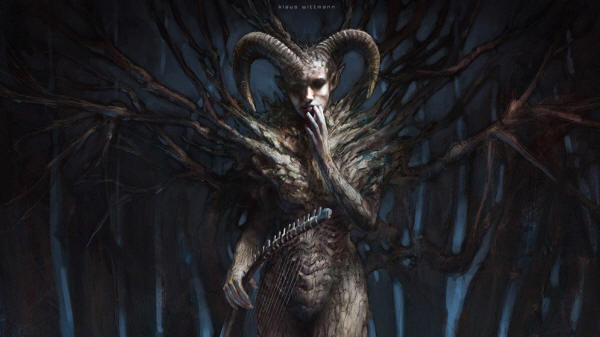|

February 21,
2018
from
AncientCode Website
Spanish version
Italian version

Image Credit:
Klaus
Wittman.
Archon or Archons were referred to in antiquity as the
servants of the Demiurge, the creator god standing between the
human race and a transcendent God that could only be reached
through knowledge of humanity's real nature as divine, leading to
the deliverance of the divine spark within humanity from the
constraints of earthly existence.
Archon is also a Greek word meaning "ruler," which was also
often used in ancient times as the title of a certain public office
in a government.
If we take a look at Archons from a Gnostic point of view, we will
understand that in this context, they were considered the angels
and demons of the old testament.
Hypostasis of
the Archons - The 'divine' creators of the universe and humanity
The rulers laid plans
and said,
"Come, let us
create a man that will be soil from the earth."
They modeled their
creature as one wholly of the earth. Now the rulers […] body […]
they have […] female […] is […] with the face of a beast.
They had taken some
soil from the earth and modeled their man after their body and
after the image of God that had appeared to them in the waters.
They said,
"Come, let us lay
hold of it by means of the form that we have modeled, so
that it may see its male counterpart […], and we may seize
it with the form that we have modeled",
...not understanding
the force of God, because of their powerlessness.
And he breathed into
his face, and the man came to have a soul (and remained) upon
the ground many days. But they could not make him arise because
of their powerlessness.
Like storm winds,
they persisted (in blowing), that they might try to capture that
image, which had appeared to them in the waters.
And they did not know
the identity of its power.
Source
Also called The
Reality of the Rulers, the Hypothesis of Archons is an exegesis
- a critical interpretation of a religious text - on the Book of
Genesis 1-6 and expresses Gnostic mythology of the divine creators
of the cosmos and humanity.
The Book of Genesis is the first book of the Hebrew Bible
(the
Tanakh) and the Christian Old
Testament.
This ancient text was revered among many other from the
Nag Hammadi Library.
The Nag Hammadi library
also called the "Chenoboskion Manuscripts," or the "Gnostic Gospels"
is a collection of a number of ancient Christian and Gnostic Texts
found in Upper Egypt in 1945.
The Reality of the Rulers is believed to have been written
sometime during the third century CE.
Researchers believe it
originated from a traditional period in Gnosticism when it was
converting from a purely mythological state into a philosophical
phase.
The writing is presented
as an instruction on the theme of the dominators (archons) of the
world mentioned by St. Paul. The express intention of this writing
is to teach the truth about the powers that have authority over
this world.
The story begins with the boast of
the demiurge, the supreme archon,
in words attributed to the God of the Bible:
"I am who I am,
God is nothing separated from me."
The Reality of the
Rulers (or
Hypostasis of the Archons) is
presented as a learned treatise where a teacher approaches a topic
suggested by the dedicatee of the work.
The treatise starts off
with a fragment of cosmogony, which guides to a revisionistic "true
history" of the events in the Genesis creation story, revealing a
Gnostic distrust of the material world and the demiurge that
conceived it.
An "angelic revelation
dialogue" emerges within this narrative where an angel repeats and
elaborates the author's fragment of cosmogonic myth in much broader
scope, concluding with a historical prophecy of the coming of the
savior and the end of days.
Bentley Layton, Professor of Religious Studies (Ancient
Christianity) and Professor of Near Eastern Languages and
Civilizations (Coptic) at Yale University writes,
"The Reality of the
Rulers ('Hypostasis of the Archons') recounts the gnostic story
from the creation of
Yaldabaoth down to Noah and the
great flood and finalizes with a prediction of the final advent
of the savior, the destruction of demonic powers, and the
victory of the Gnostics."
As noted by Roger A.
Bullard in his book "The
Hypostasis of the Archons - The Coptic Text with Translation and
Commentary", the beginning and conclusion to the text are
Christian Gnostic, but the remaining of the material is a
mythological account about the origin and nature of the archontic
powers peopling the skies between Earth and
the Ogdoad, and how these ancient
events influence the destiny of man.
Although not related at this point,
is it possible that
the so-called Archons were somehow connected to
the Ancient Anunnaki?
Food for thought...
According to the Hypostasis of the Archons, these are the
Mythic characters:
-
The Parent of the
Entirety: The invisible virgin spirit
-
Incorruptibility
-
The Child:
Presides over the entirety
-
The Four
Luminaries: Eleleth and three others
-
The True Human
Being
-
The Undominated
Race
-
Wisdom: Sophia or
Pistis Sophia
-
Zoe (Life):
daughter of Sophia
-
Yaldabaoth: The
chief ruler also called Sakla and Samael
-
Sabaoth: One of
Yaldabaoth's first seven offspring
-
Adam: The first
human being
-
Eve: Adam's wife
and counterpart
-
Cain: Eve's son
begotten by the rulers
-
Abel: Eve's son
begotten by Adam
-
Seth: a son
through god
-
Norea: Eve's
daughter
|


